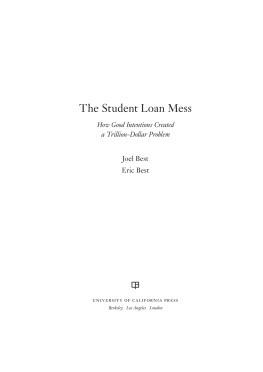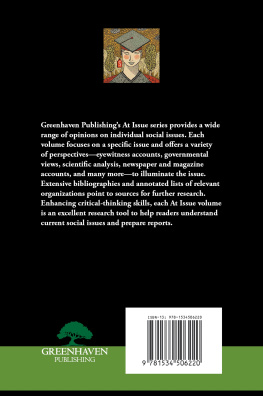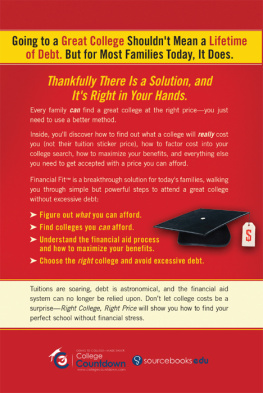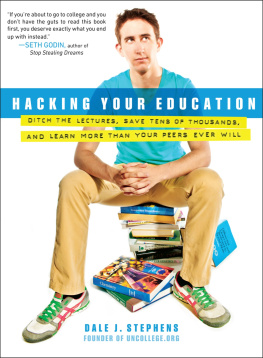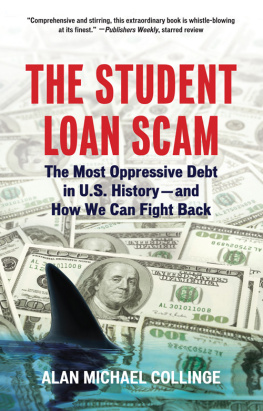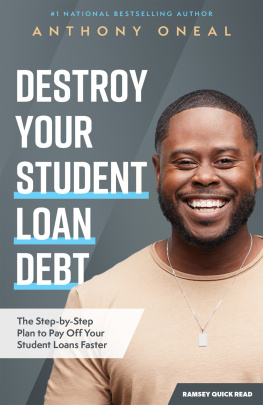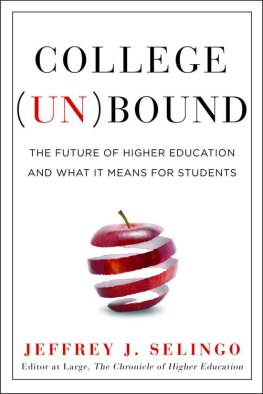The Atkinson Family Foundation has endowed this imprint to illuminate the role of higher education in contemporary society.
The publisher gratefully acknowledges the generous support of the Atkinson Family Imprint in Higher Education of the University of California Press Foundation, which was established by a major gift from the Atkinson Family Foundation.
The Student Loan Mess
How Good Intentions Created a Trillion-Dollar Problem
Joel Best
Eric Best

UNIVERSITY OF CALIFORNIA PRESS
Berkeley Los Angeles London
University of California Press, one of the most distinguished university presses in the United States, enriches lives around the world by advancing scholarship in the humanities, social sciences, and natural sciences. Its activities are supported by the UC Press Foundation and by philanthropic contributions from individuals and institutions. For more information, visit www.ucpress.edu.
University of California Press
Berkeley and Los Angeles, California
University of California Press, Ltd.
London, England
2014 by The Regents of the University of California
Awake at last. Editorial cartoon by Edwin Marcus, New York Times (October 13, 1957). Used by permission of the Marcus Family.
Does this mean we have to sell the Porsche? Editorial cartoon by Kate Salley Palmer, Greenville [SC] News (December 14, 1982). Used by permission of the Kate Salley Palmer Collection, The Ohio State University Cartoon Library and Museum.
We are moving back into my old room. Editorial cartoon by John Darkow, Columbia [MO] Daily Tribune (October 28, 2011). Used by permission of Cagle Cartoons.
Stylized Flow of Student Loan Processing. Reprinted from Edmiston, Brooks, and Shelpelwich, Student Loans: Overview and Issues (Update). Federal Reserve Bank of Kansas City Research Working Papers, April 2013. Used by permission.
Arent you tired of the rankings? Doonesbury comic strip by Garry B. Trudeau (August 7, 2012). Used by permission of Universal Uclick. All rights reserved.
The True Size of the Student Debt Crisis. Dmos.org (2013). Used by permission.
Library of Congress Cataloging-in-Publication Data
Best, Joel.
The student loan mess : how good intentions created a trillion-dollar problem / Joel Best, Eric Best.
pages cm
Includes bibliographical references and index.
ISBN 978-0-520-27645-1 (hardback) ISBN 978-0-520-95844-9 (e-book)
1. Student loansUnited States. 2. Student loansGovernment policyUnited States. 3. College graduatesUnited StatesFinance, Personal. I. Best, Eric. II. Title.
LB 2340.2. B 48 2014
378.362dc23
2013043272
Manufactured in the United States of America
23 22 21 20 19 18 17 16 15 14
10 9 8 7 6 5 4 3 2 1
In keeping with a commitment to support environmentally responsible and sustainable printing practices, UC Press has printed this book on Natures Natural, a fiber that contains 30% post-consumer waste and meets the minimum requirements of ANSI/NISO Z 39.481992 ( R 1997) ( Permanence of Paper ).
CONTENTS
FIGURES AND TABLE
FIGURES
TABLE
ACKNOWLEDGMENTS
A lot of people get interested when you tell them youre writing about student loans. We have lost track of all the people who directed our attention to specific topics and sources, and we apologize. However, we do want to thank Joan Best, Richard J. Mahoney, Michele Maughan, Dan Rich, and Leland Ware, who took the time to go through our entire manuscript and give us valuable feedback. Any errors and omissions are our own. We also want to thank the folks at the University of California Press who helped us create this book, especially Naomi Schneider, Dore Brown, Elizabeth Berg, and Christopher Lura.
Introduction
In 2012, when we decided to write this book, student loans had becomereally for the first time evera hot topic. Protesters in the Occupy Wall Street movement called for forgiving all student loan debt, even as the high unemployment rate encouraged more young people to stay out of the workforce and pursue a college education. There were news reports that total student loan debt had reached a trillion dollars, that Americans now owed more on student loans than on their credit cards. Young people leaving school were finding that their student loan debt made it vastly harder to launch careers, start families, or buy homes. Some critics warned about an expanding student loan bubble that would inevitably pop and drive the economy into another severe recession, while others challenged the established wisdom that going to college was the most promising route to fulfilling the American Dream.
How, you might ask, did we get into this mess?
This book tries to answer that question. But it doesnt concentrate solely on this mess (that is, todays complaints about that trillion-dollar debt, the frustrations of young people trying to deal with massive student loan debt on top of all the other challenges they face, or potential consequences should the bubble burst). Instead, we adopt a broader perspective. Our goal is to understand how we got into this mess. And that turns out to be a really interesting story.
It is a story of good intentions gone awry. (Recall the proverb, more than three hundred years old: The road to hell is paved with good intentions.) Federal student loan programs started as a way to help young Americans get ahead during the Cold War years of the 1950s and 1960s: student loans seemed to offer a solution to what was then considered a social problemtoo many bright kids couldnt afford to go to college, causing America to waste precious brainpower. Well call that the first student loan mess.
The earliest student loan programs were inspired by idealism, but were telling an ironic story. Policies designed to solve social problems dont always work as planned; they can create new, unexpected difficulties. Thus, while we might like to imagine that there is only a single student loan mess, our story is about a series of student loan messes, each a reaction to how people understood and tried to resolve an earlier mess. For example, solving the first student loan mess by creating loan programs that would give every promising young person access to college had an unexpected consequence: too many borrowers failed to repay their student loans, and that problemdeadbeat studentsbecame what well call the second student loan mess. This cyclethe solution to one mess creating the conditions that came to be understood as the next, even bigger messhas repeated itself several times and continues today. So the short answer to our question is that we got into our current student loan mess by trying to solve earlier messes, and our next mess is likely to be shaped by what we do to solve the one were in right now. This is both a surprising story and an important one. We didnt wind up in our current mess by accident; we got there by creating well-intentioned policies without thinking through the likely consequences of our actions. And if we want to avoid setting the stage for an even bigger mess, we ought to ask ourselves what we can learn from the tangled history of student loans.
This book is the product of an intergenerational collaboration: Joel and Eric are father and son. We approach our topic from different Recognizing that the topic interested both of us but appreciating that we saw it from different angles, we decided to join forces.

